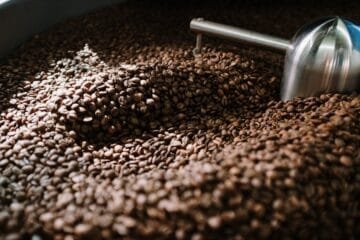Just as each region has its unique culture, the way coffee beans are roasted varies significantly across the globe. You might wonder how factors such as climate, local traditions, and bean varieties influence roasting techniques. Understanding these differences can enhance your appreciation for your morning cup, showcasing not just flavor but also a story of heritage and craftsmanship. Whether you prefer a bold French roast or a light Ethiopian brew, exploring the reasons behind these diverse roasting methods can deepen your connection to this beloved beverage.
Key Takeaways:
- Different roasting methods reflect local climate, culture, and historical practices, resulting in a wide variation in flavor profiles.
- Regional preferences influence the desired roast level, with lighter roasts often favored in some areas for their brightness, while darker roasts are preferred in others for their rich, bold flavors.
- The availability of coffee bean varieties and specific processing techniques also play a significant role in how beans are roasted, contributing to the distinctive characteristics of global coffee styles.
Cultural Influences on Coffee Roasting Techniques
Your experience with coffee is deeply intertwined with culture, as different regions have cultivated unique roasting styles shaped by tradition and values. Countries such as Italy and Brazil have developed distinct preferences that influence how they roast their beans. For deeper insights into the interplay between culture and caffeine, check out the Definition and History of Coffee & Different Roasts.
Regional Palates: How Taste Preferences Shape Roasting
Regional taste preferences significantly impact how coffee beans are roasted. In Ethiopia, for instance, you might find a lighter roast that highlights floral notes, while in Italy, a darker roast is favored for its bold, rich flavors. As a result, local tastes dictate the roasting process, creating a diverse spectrum of coffee experiences that reflect each culture’s palate.
Festivities and Traditions: Celebrating Coffee in Various Cultures
Coffee plays a pivotal role in various cultural festivities, often serving as a symbol of community and celebration. For example, in Colombia, coffee is celebrated during the National Coffee Festival, where locals partake in events such as parades and traditional dances, showcasing the significance of this beloved beverage. In Turkey, coffee is deeply ingrained in social rituals, with the preparation of Turkish coffee being a time-honored tradition that reflects hospitality and artistry.
Throughout the world, coffee transcends mere consumption; it becomes an integral part of cultural identity. In Mexico, for instance, the Day of the Dead is celebrated with sugar skulls alongside traditional coffee beverages, symbolizing the union of life and death. Meanwhile, Scandinavian countries host coffee breaks known as “fika,” emphasizing the importance of community and relaxation. These examples underscore that coffee isn’t just a drink—it’s a vessel for festivity and tradition, intertwining flavors with cherished cultural practices.
The Role of Climate and Geography in Bean Characteristics
Your coffee’s unique flavor begins long before it hits the roaster. The climate and geography of coffee-growing regions greatly influence the characteristics of the beans. Factors such as temperature, precipitation, and humidity determine the growth conditions for coffee plants, directly affecting bean development. For instance, beans grown in higher altitudes often exhibit brighter acidity and complexity, while those cultivated in lower regions may have a fuller body and a deeper taste profile. Such distinct characteristics highlight the diverse nature of coffee beans across the globe.
The Impact of Altitude and Environment on Flavor Profiles
Altitude plays a significant role in the flavor profiles of coffee. As elevation increases, cooler temperatures slow down the maturation of the coffee cherries, allowing for more complex flavors to develop. For example, Colombian coffee, often grown in mountainous regions, is celebrated for its bright acidity and rich, floral notes. In contrast, beans from lower altitudes typically lean towards a smoother, chocolaty flavor, showcasing the direct impact of the growing environment on your cup.
Soil Quality and Its Contribution to Bean Attributes
The quality of the soil where coffee plants are rooted significantly shapes their attributes. Beans grown in nutrient-rich volcanic soil, such as that found in parts of Hawaii and Ethiopia, often exhibit vibrant flavors and pronounced sweetness. In contrast, poor soil conditions can lead to underdeveloped flavors and lower quality beans. Soil pH, texture, and mineral content are all influential factors, shaping the final taste of your brew.
Specific composition of soil is integral to the nutrients absorbed by coffee plants. For instance, the presence of nitrogen, phosphorus, and potassium directly influences plant health and coffee quality. Volcanic soils, prevalent in regions like Colombia and Costa Rica, are particularly fertile, contributing to beans that express high acidity and complex flavor profiles. Conversely, clay-heavy soils can retain water but may lead to weaker flavors due to poor drainage. Understanding soil types and their impact can enhance your appreciation for the distinctive qualities found in your coffee cup.
Historical Context: Roasting Practices Through Time
Roasting practices date back centuries, intricately linked to the cultural and economic shifts of societies. Initially, coffee beans were often roasted over open flames, resulting in varying degrees of flavor from light to dark. As availability spread from the Middle East to Europe in the 17th century, distinct regional preferences emerged, leading to the diverse roasting styles familiar today. The quest for perfection motivated innovators to experiment with techniques, gradually shaping how coffee has been appreciated throughout history.
Colonial Legacies: The Adoption of Coffee Roasting Methods
The colonial era significantly influenced coffee roasting methods, as European powers established plantations across Asia, Africa, and South America. Different regions adopted and adapted these techniques based on local customs and available resources. For instance, in Ethiopia, traditional roasting often occurs in homes as a social ritual, while in Brazil, large-scale roasting reflects industrial advancements. These practices foster distinct flavors and contributed to the global coffee culture you experience today.
The Evolution of Roasting Equipment and Methods
Roasting equipment and methods have advanced dramatically over the years, transforming how you enjoy coffee. In the early days, simple manual devices, like pan roasters, were the norm. As coffee popularity rose, machines such as the drum roaster emerged in the 19th century, allowing for more controlled roasting times and temperatures. Today, modern technology integrates digital controls and air roasting techniques, enhancing flavor consistency. This evolution has turned the craft of roasting into a precise science, catering to the diverse tastes you find around the world.
With advancements in roasting equipment, you see a fascinating blend of tradition and innovation. Updated roasting machines can precisely calibrate time and temperature, allowing for more personalized flavor development. The industry now embraces methods like fluid bed roasting, which circulates hot air, ensuring even heat distribution. As a result, you benefit from a range of unique flavor profiles, showcasing the very best of what each origin can offer. This evolution reflects a broader trend in the coffee industry where craftsmanship meets technology, continually elevating your coffee experience.
Scientific Principles Behind Roasting Variants
Variations in coffee roasting stem from intricate scientific principles that dictate how beans transform under heat. Every roast draws on a unique combination of temperature, duration, and chemical reactions, all resulting in distinct flavor profiles. These elements work in tandem to influence the Maillard reaction, caramelization, and ultimately, your coffee experience. Understanding these processes illuminates why roasting preferences vary globally.
Chemical Reactions: Maillard Reaction and Its Effects on Flavor
The Maillard reaction is pivotal in developing your coffee’s flavor during roasting. This complex series of reactions occurs between amino acids and reducing sugars when beans are exposed to heat, resulting in the formation of an astonishing array of flavor compounds. As the beans darken, their aromatic profiles evolve, creating flavors ranging from nutty and chocolaty to fruity or floral. The extent of the reaction greatly determines your coffee’s final taste.
Temperature and Time: Finding the Perfect Roast Balance
Achieving the right roast balance hinges on precisely controlling both temperature and time. Typically, roasting occurs within a temperature range of 370°F to 540°F (190°C to 280°C). Shorter roast durations at high temperatures can yield brighter flavors, while longer roasts at lower temperatures enhance body and sweetness. The challenge lies in tailoring these variables to match the distinct characteristics of the beans you’re using.
| Temperature Range | Indicates the preferred roasting heat levels for desired outcomes. |
| Roast Duration | Short roasting may maintain acidity, while longer durations bring out more sweetness. |
Finding the optimal roast requires experimenting with time and temperature. As you roast beans, pay attention to the sounds emitted, known as the first and second crack. The first crack usually signals that the beans are reaching the light roast phase, where acidity is pronounced, whereas the second crack indicates darker roast levels, enhancing sweetness and depth. Each coffee bean’s origin plays a role in how these elements interact, so adjust to unlock the best flavor profiles specific to your beans.
| Bean Origin | Each region’s beans may require different roasting approaches for optimal flavor. |
| Roasting Equipment | The type of roaster and its capabilities can influence consistency and flavor development. |
Global Trade Dynamics and Its Influence on Roasting Styles
The global coffee trade significantly shapes roasting styles, influenced by factors such as origin, demand, and consumer preferences. Different regions have distinct flavor profiles, and as coffee travels across borders, How Coffees from Different Parts of the World Taste serves as a guiding principle for roasters. These regional variations affect how beans are roasted, ensuring that the unique characteristics of each origin are preserved and celebrated.
Supply Chain Factors: Access to Beans and Roasting Choices
Access to high-quality beans heavily influences roasting choices, shaping the flavor and aroma of the final product. Roasters prioritize certain origins based on availability and local preferences, often utilizing proprietary methods to enhance the beans’ inherent qualities. Factors that affect this dynamic include:
- Availability of beans influenced by climate and fair trade practices.
- Transportation costs that dictate access to diverse coffee types.
- Consumer demand for specific flavors tied to different regions.
This interplay between supply and demand shapes the local roasting methods you encounter globally.
Economic Factors: Pricing Strategies and Their Impact on Roasting
Pricing strategies also play a vital role in the roasting process, as they can dictate the types of beans that are economically viable for different markets. Changes in the global marketplace can lead to fluctuations in bean prices, influencing roasters to adapt their methods accordingly. Considerations in this context include:
- Cost of production related to labor and sourcing.
- Market trends that drive consumer preferences.
- Competitive pricing that forces adjustments in roasting styles.
Any shift in costs can directly influence how roasters approach flavor balancing and roasting techniques tailored to consumer expectations.
For instance, small-scale roasters may lean towards artisanal methods that emphasize quality over quantity, while larger companies might employ mass production techniques that accommodate wider price ranges. This dynamic inevitably leads to the emergence of new roasting styles that reflect both consumer desires and economic realities. Considerations in this context include:
- Profit margins that dictate strategic choices.
- Investment in technology or sustainable practices.
- Marketing strategies that impact bean selection and roasting profiles.
Any shifts in costs can dictate changes in how roasters align their offerings with market expectations.
Summing up
With these considerations, you can appreciate that the diversity in coffee bean roasting reflects cultural preferences, local climates, and unique traditions around the world. Each roasting method influences the flavor, aroma, and overall coffee experience, making your daily cup not just a beverage but a glimpse into the heritage of each region. Understanding these differences can enhance your enjoyment and appreciation of coffee, allowing you to explore new flavors that resonate with your palate while celebrating the rich global tapestry of this beloved drink.
Q: Why do different regions roast coffee beans differently?
A: The roasting process varies by region due to local preferences, traditions, and the unique flavor profiles of beans grown in those areas. For instance, in countries like Italy, darker roasts are popular, which enhances boldness and reduces acidity, aligning with their preferred method of espresso preparation. Conversely, in regions like Ethiopia, where lighter roasts are favored, the objective is to highlight the distinct fruity and floral notes inherent to the beans. These cultural factors influence not only the roasting techniques but also how coffee is enjoyed in social settings.
Q: How does the type of coffee bean affect roasting methods globally?
A: The type of coffee bean plays a significant role in determining the appropriate roasting method. Arabica beans, which are known for their smooth and complex flavors, may be roasted lighter to preserve their delicate characteristics. Meanwhile, robusta beans, which tend to have a stronger and more bitter taste, are often roasted darker to create a richer and fuller flavor. Different countries often focus on specific bean varieties, resulting in roasting methods that cater specifically to each bean’s unique qualities, ultimately shaping the global coffee landscape.
Q: What impact does local climate have on coffee roasting styles?
A: Local climate can significantly influence coffee roasting styles and preferences. In regions with warmer climates, like Brazil, the focus tends to be on developing a more caramelized, sweeter profile through medium to dark roasts. In contrast, in cooler climates such as Scandinavia, lighter roasts are popular, allowing for brighter acidity and nuanced flavors to shine through. Additionally, local populations may have different habits and preferences around drinking coffee, which further refines how beans are roasted and enjoyed across various parts of the world.




